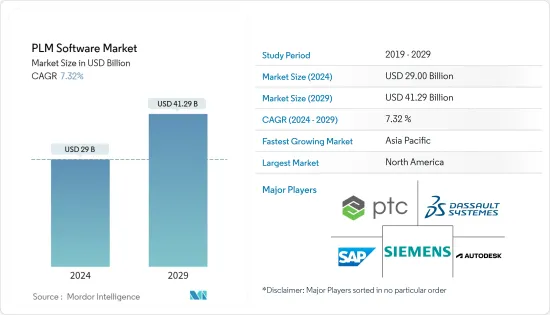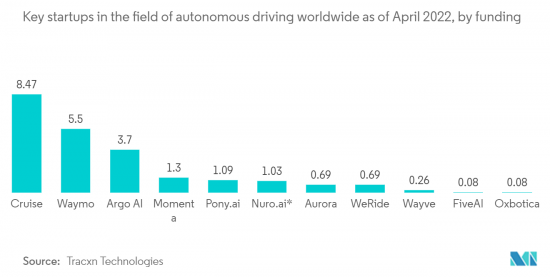 |
市場調查報告書
商品編碼
1404422
PLM 軟體:市場佔有率分析、產業趨勢/統計、成長預測,2024-2029 年PLM Software - Market Share Analysis, Industry Trends & Statistics, Growth Forecasts 2024 - 2029 |
||||||
※ 本網頁內容可能與最新版本有所差異。詳細情況請與我們聯繫。
PLM 軟體市場規模預計到 2024 年將達到 290 億美元,預計到 2029 年將達到 412.9 億美元,在預測期內(2024-2029 年)複合年成長率為 7.32%。

業界對強大的資料分析軟體平台的需求不斷成長。這一趨勢也得到了整個製造業擴大採用物聯網的支持。 PTC 的 Windchill 是 PLM 軟體的一個範例,它為尋求 IoT 功能的離散製造商提供了分析功能。該軟體可以提高 PLM 解決方案的彈性。
主要亮點
- 數位化將產品從實體商品和有形服務轉變為數位雙胞胎,即實體產品的複製品。工業4.0是一項重要舉措,旨在透過降低生產成本來提高競爭力,同時利用產品數位化來提高產品品質和生產擴充性。 SAP正在探索數位供應鏈場景,讓各個供應商直接向區塊鏈平台提交報價,從而提高整個業務網路的效率。
- 此外,PLM 還可以縮短核准時間並加快產品上市速度,從而幫助實施公司減少延誤和成本。例如,2022 年 9 月,AVEVA Solutions Limited 與 Aras 建立了策略OEM合作夥伴關係,提供工業「資產生命週期管理」解決方案。 AVEVA 已授權 Aras Innovator Platform 提供一套高度擴充性的資產生命週期管理解決方案,該解決方案將 Aras 靈活、開放的應用程式組合與 AVEVA 資產資訊管理和 AVEVA 統一工程整合在一起。
- 生產過程中擴大採用工業IoT(IIoT) 正在推動市場對軟體應用程式的需求,預計 IIoT 的採用率將在預測期內激增。例如,根據 GSMA Intelligence 的數據,到 2025 年,IIoT 連線物件的數量預計將達到 137 億個。
- 例如,電動車製造商Simple Energy於2022年1月與西門子合作,實現電動車製造業的數位轉型。這家電動車製造商也提到共用技術,包括與 Prolim 共享技術,以加強其在印度的電動車產品組合。作為合作夥伴關係的一部分,Simple Energy 將採用西門子雲端基礎的產品生命週期管理 (PLM) 軟體 Teamcenter X,為其電動車解決方案奠定強大的數位基礎。
- 然而,隨著兩家公司不斷提供不同的產品和產品系列來參與市場競爭,互通性問題已經出現,軟體公司需要不斷最佳化。軟體產品的持續改進使得將軟體實施到公司現有的產品系列中更加精簡、更易於管理,並且更有可能產生更好的結果。
- 許多製造業受到了 COVID-19大流行的影響,導致供應鏈出現嚴重缺口和延誤。這迫使許多產業加速工業 4.0 實施和數位轉型工作,增加對 PLM 軟體的需求,以推動必要的成長率。疫情後軟體普及的增加也推動了市場的成長。
PLM軟體市場趨勢
自動駕駛汽車產量的增加推動市場成長
- 隨著自動駕駛汽車的快速普及,主要從事自動駕駛汽車開發的開發人員必須面對一些日益複雜的挑戰,這需要重新設計現有流程和工具集,並需要進行評估。因此,克服這些挑戰的日益成長的需求正在推動市場呈指數級成長。
- 此外,功能齊全的自動駕駛系統結合了各種資料饋送,包括來自感測器的資訊、來自雲端的交通資料以及來自其他基礎設施和車輛的資料,所有這些都連接到車輛的機械和電子系統。汽車製造商需要使用複雜的軟體來連接組件並創建龐大的汽車系統網路,這些系統可以可靠地協同工作,無需用戶輸入或修改。需要實施。
- 整合的ALM(應用程式生命週期管理)和codeBeamer ALM 等產品開發平台旨在解決自動駕駛汽車領域產品複雜性增加以及產品對高級軟體應用程式依賴所帶來的挑戰。我認為這將有助於實現開發流程的現代化。
- 數位化製造使用的增加和自動駕駛汽車需求的增加是預計在估計期間推動汽車行業 PLM 軟體市場的主要趨勢。例如,2022 年 10 月,西門子和 Applied EV 宣佈建立合作夥伴關係,利用西門子的 PLM 軟體來增強自動駕駛汽車的設計、組裝和品質保證。西門子軟體正在幫助電動車公司透過更好的變革管理和品質來滿足對全自動駕駛汽車日益成長的需求。
- 2023 年 6 月,世界上最強大的低代碼平台 Aras 宣布,全球汽車製造商 Nissan 將利用 Aras Innovators 來簡化車上用軟體版本的管理。 。此舉正值日產汽車公司擴大電動車產量以滿足不斷成長的消費者需求之際。

北美佔有很大佔有率
- 北美強大的金融基礎使其能夠進行大量投資,特別是在提高市場競爭力的先進技術和解決方案方面。此外,該地區也是許多主要產品生命週期管理軟體供應商的所在地,包括 IBM 公司、PTC 公司和 Oracle 公司。因此,市場競爭異常激烈。
- 整個北美汽車工業正在快速成長。 PLM 軟體主要在產品開發階段使用,在汽車產業中,這個階段早在製造開始之前就開始了。 PLM 軟體可確保車輛的先進安全功能、電子設備和內建軟體內容。因此,隨著該地區汽車行業的崛起,預計該市場在整個預測期內將享受各種利潤豐厚的成長機會。
- 其他製造業和市場正在探索實施 PLM 軟體的好處,以增強其製造和生產流程。例如,2023 年 4 月,西門子和微軟將利用生成式人工智慧的集體協作力量,幫助工業企業在其產品的工程、設計、製造和營運生命週期中提高效率和創新。此外,為了加強跨職能協作,兩家公司專注於將西門子的 Teamcenter 產品生命週期管理軟體與微軟的協作平台 Teams、Azure OpenAI 服務的語言模型以及各種其他 Azure AI 功能整合。
- 2022 年 9 月,PTC 宣布推出 Onshape-Arena Connection,這是一項新功能,可連接主要雲端原生的 Onshape 產品開發解決方案和 Arena 產品生命週期管理解決方案。透過此連接,公司只需單擊一個按鈕即可在 Arena 和 Onshape 解決方案之間即時共用產品資料,從而幫助公司增強產品開發流程並簡化與供應鏈合作夥伴的協作。
- 此類合作強化了整體市場格局,並激勵其他競爭和供應商啟用 PLM 軟體,從而塑造了龐大的 PLM 實施的整個北美市場。因此,產品供應鏈各個方面的徹底實施正在積極支持北美企業不斷發展的工業4.0趨勢。
PLM 軟體產業概覽
產品生命週期管理 (PLM) 軟體市場高度分散且競爭激烈,這主要是由於眾多全球參與者的存在。各市場參與者充分利用最新的軟體技術進行研發,在市場上建立了較高的競爭力。主要參與者包括 Dassault Systemes Deutschland GmbH、Siemens、Autodesk Inc.、ANSYS Inc. 和 Infor Inc.。公司透過建立各種合作夥伴關係、投資計劃以及向市場推出新產品來最大化其市場佔有率。
2023 年 2 月,Hexagon 旗下公司、全球協作和設計解決方案提供商 Bricsys 宣布與 MechWorks(隸屬於 ITI Technegroup、隸屬於 WIPRO)建立合作夥伴關係,提供西門子 Teamcenter 軟體與 BricsCAD 的整合。此解決方案主要提供業界領先的功能,可更快地連接 BricsCAD 流程,讓設計人員能夠專注於產品開發。
2022 年 9 月,歐洲數位轉型聯盟的主要股東 Holland Capital 成功收購了 OnePLM,與 Magnus Digital、Dimensys、Cards PLM Solutions 和 Appronto 形成互補。這創建了歐洲最大的軟體服務供應商,使國際客戶能夠從一流專家提供的大量服務中受益。
其他福利
- Excel 格式的市場預測 (ME) 表
- 3 個月的分析師支持
目錄
第1章簡介
- 研究假設和市場定義
- 調查範圍
第2章調查方法
第3章執行摘要
第4章市場洞察
- 市場概況
- 產業吸引力-波特五力分析
- 供應商的議價能力
- 消費者議價能力
- 新進入者的威脅
- 替代品的威脅
- 競爭公司之間的敵對關係
- COVID-19 對產品生命週期管理軟體市場的影響
第5章市場動態
- 市場促進因素
- 引入數位化以提高生產力
- 引進雲端技術進行資訊集中
- 市場抑制因素
- 不同產品版本之間缺乏互通性
第6章市場區隔
- 依部署類型
- 本地
- 雲
- 專業的服務
- 按最終用戶產業
- 電子、工業設備、高科技
- 航太/國防
- 車
- 架構、工程與施工 (AEC)
- 其他
- 按地區
- 北美洲
- 歐洲
- 亞太地區
- 拉丁美洲
- 中東/非洲
第7章競爭形勢
- 公司簡介
- Siemens AG
- Dassault Systems Deutschland GmbH
- Autodesk Inc.
- PTC Inc.
- SAP SE
- ANSYS Germany GmbH
- Oracle Corporation
- Aras Corporation
- Arena Solutions
- Infor Inc.
第8章投資分析
第9章市場的未來

The PLM Software Market size is estimated at USD 29 billion in 2024, and is expected to reach USD 41.29 billion by 2029, growing at a CAGR of 7.32% during the forecast period (2024-2029).
The demand for robust data analytics software platforms in the industry is increasing. The increasing adoption of IoT across the manufacturing industry has augmented these trends. PTC's Windchill is an instance of the PLM software embedded with analytics for discrete manufacturers looking for IoT capabilities. This software can boost the PLM solution to sprint with flexibility.
Key Highlights
- Digitalization transforms products from physical goods and tangible services into digital twins, replicas of the physical product. Industry 4.0 is an important focus aiming at increasing competitiveness by targeting the reduction of production costs while improving product quality and production scalability by utilizing the digitalization of products. SAP explores digital supply chain scenarios where different suppliers submit offers directly to a blockchain platform to improve effectiveness across their business networks.
- In addition, PLM helps improve approval times and reduce delays by accelerating product introduction to the market, saving costs for adopters. For example, in September 2022, AVEVA Solutions Limited and Aras entered a strategic OEM partnership to deliver industrial 'Asset Lifecycle Management' solutions. AVEVA would license the Aras Innovator platform for providing a series of scalable Asset Lifecycle Management solutions that would integrate Aras' flexible and open portfolio of applications with AVEVA Asset Information Management and AVEVA Unified Engineering.
- The increased adoption of Industrial IoT (IIoT) in the production process is aiding the market demand for software applications, and IIoT adoption is expected to skyrocket over the forecast period. For instance, according to GSMA Intelligence, the number of IIoT-connected objects is expected to reach 13.7 billion by 2025.
- For example, in January 2022, Simple Energy, the EV maker, partnered with Siemens and enabled digital transformation in the EV manufacturing industry. The EV company also mentioned including Prolim to share its technologies to strengthen the EV portfolio in India. As part of the partnership, Simple Energy would adopt Siemen's cloud-based product lifecycle management (PLM) software Teamcenter X to establish a robust digital foundation in e-mobility solutions.
- However, as the companies continue to provide different products and product ranges to tackle market competitiveness, it creates interoperability issues, a matter of constant optimization for the software companies. As continuous improvements continue in the software products, the software implementation in a company's existing product line-up becomes streamlined and manageable, facilitating better results.
- Many manufacturing industries were affected by the COVID-19 pandemic, creating significant supply chain gaps, and leading to delays. This forced many industries to hasten the Industry 4.0 adoption and digital transformation initiatives, boosting the demand for PLM software to bolster the required growth rates. The increased software penetration after the pandemic has boosted market growth.
PLM Software Market Trends
Increasing Production of Autonomous Vehicles to Drive the Market Growth
- Due to the rapid penetration of autonomous vehicles, the developers primarily working on autonomous vehicles have to face several increasingly complex challenges and, consequently, need to reevaluate their existing processes and toolsets. Hence, the rising need to overcome these challenges is fuelling the market's growth exponentially.
- Moreover, the fully functional autonomous driving systems need some of the most complex and sophisticated software implementations that carmakers have ever faced for combining a variety of data feeds, like information from sensors, traffic data from the cloud, data coming from other infrastructure or vehicles, and tying it all into the automobiles's mechanical and electronic components to create a vast network of onboard systems that all work together reliably without the need for user input or correction.
- The integrated ALM (Application Lifecycle Management) and product development platforms, such as codeBeamer ALM, will be instrumental in modernizing development processes for tackling the challenges introduced by the increasing product complexity and the growing reliance of products on sophisticated software applications in the autonomous vehicle sector.
- The rising usage of digital manufacturing and the increasing demand for autonomous cars is a key trend expected to drive the PLM software market in the automotive sector during the estimated period. For instance, in October 2022, Siemens and Applied EV declared a partnership with the EV company to utilize Siemens' PLM software to enhance autonomous vehicle design, assembly, and quality assurance. Siemens' software was helping the EV firm meet the growing demand for fully autonomous vehicles through better change management and quality.
- In June 2023, Aras, which provides the most powerful low-code platform with applications to design, build, and operate complex products, declared that global car manufacturer Nissan Motor Co. Ltd. is utilizing Aras Innovator to streamline the management of complex in-vehicle software variants. This move comes as Nissan extends its electric car production to fulfill the rising consumer demand.

North America to Account for a Significant Share
- North America's strong financial position allows it to invest massively, especially in advanced technologies and solutions that have offered a strong competitive edge within the market. Moreover, the region has a robust presence of several significant product lifecycle management software vendors like IBM Corp., PTC Inc., Oracle Corporation, and many others. Hence, there lies intense competition among the market players.
- The entire automotive industry in North America is growing at a rapid pace. PLM software is primarily utilized in the product development stage, which starts long before manufacturing begins in the automotive industry. It ensures the vehicles' advanced safety features, electronics, and embedded software content. Hence, with the rise in the automotive industry within the region, the market is expected to have various lucrative growth opportunities throughout the forecast period.
- Other manufacturing industries and markets explore the benefits of deploying PLM software to augment manufacturing and production processes. For instance, in April 2023, Siemens and Microsoft are harnessing the overall collaborative power of generative artificial intelligence mainly to help industrial companies drive efficiency and innovation across the engineering, design, manufacturing, and operational lifecycle of the products. Also, to enhance cross-functional collaboration, the companies are focused on integrating Siemens' Teamcenter software for product lifecycle management with the collaboration platform of Microsoft, Teams, and its language models in Azure OpenAI Service, as well as various other Azure AI capabilities.
- In September 2022, PTC declared the availability of the Onshape-Arena Connection, a new functionality that mainly connected its cloud-native Onshape product development and Arena product lifecycle management solutions. The Connection allowed the product data to be shared instantly between the Arena and Onshape solutions with the single click of a button, assisting the companies in augmenting the product development process and simplifying collaboration with the supply chain partners.
- Such collaborations enhance the entire market scenario, stimulating other competitors and vendors to enable PLM software and shaping the whole North American market for vast PLM implementation. Hence, the in-depth implementation throughout several aspects of the product supply chain is actively helping North America's businesses with the evolving Industry 4.0 trends.
PLM Software Industry Overview
The Product Lifecycle Management (PLM) software market is highly fragmented and competitive, mainly due to the presence of numerous global players. Various market players are moving in R&D with the latest software techniques, building a high level of competitiveness throughout the market. The key players include Dassault Systemes Deutschland GmbH, Siemens, Autodesk Inc., ANSYS Inc., Infor Inc., and many others. The companies are thus maximizing their market share by forming various partnerships, investing in projects, and introducing new products in the market.
In February 2023, Global provider of collaboration and design solutions Bricsys, part of Hexagon, declared its partnership with MechWorks, part of ITI Technegroup, a WIPRO Company, to offer an integration between Siemens' Teamcenter software and BricsCAD. The solution primarily provides industry-best features to connect BricsCAD's processes faster and enable designers to focus on its product development.
In September 2022, Holland Capital, the key shareholder of the European Digital Transformation consortium, successfully acquired OnePLM to complement Magnus Digital, Dimensys, Cards PLM Solutions, and Appronto. This created the largest software and service provider of its kind in Europe and allowed international customers to benefit from a vast range of best-in-class expert services.
Additional Benefits:
- The market estimate (ME) sheet in Excel format
- 3 months of analyst support
TABLE OF CONTENTS
1 INTRODUCTION
- 1.1 Study Assumptions and Market Definition
- 1.2 Scope of the Study
2 RESEARCH METHODOLOGY
3 EXECUTIVE SUMMARY
4 MARKET INSIGHTS
- 4.1 Market Overview
- 4.2 Industry Attractiveness - Porter's Five Forces Analysis
- 4.2.1 Bargaining Power of Suppliers
- 4.2.2 Bargaining Power of Consumers
- 4.2.3 Threat of New Entrants
- 4.2.4 Threat of Substitutes
- 4.2.5 Intensity of Competitive Rivalry
- 4.3 Impact of COVID-19 on the Product Lifecycle Management Software Market
5 MARKET DYNAMICS
- 5.1 Market Drivers
- 5.1.1 Adoption of Digitalization to Improve Production
- 5.1.2 Introduction of Cloud Technology to Consolidate the Information
- 5.2 Market Restraints
- 5.2.1 Lack of Interoperability among Dissimilar Product Versions
6 MARKET SEGMENTATION
- 6.1 By Deployment Type
- 6.1.1 On-premise
- 6.1.2 Cloud
- 6.1.3 Professional Services
- 6.2 By End-user Industry
- 6.2.1 Electronics, Industrial Equipment, and High-tech
- 6.2.2 Aerospace and Defense
- 6.2.3 Automotive
- 6.2.4 Architecture, Engineering, and Construction (AEC)
- 6.2.5 Other End-user Industries
- 6.3 By Geography
- 6.3.1 North America
- 6.3.2 Europe
- 6.3.3 Asia-Pacific
- 6.3.4 Latin America
- 6.3.5 Middle East & Africa
7 COMPETITIVE LANDSCAPE
- 7.1 Company Profiles
- 7.1.1 Siemens AG
- 7.1.2 Dassault Systems Deutschland GmbH
- 7.1.3 Autodesk Inc.
- 7.1.4 PTC Inc.
- 7.1.5 SAP SE
- 7.1.6 ANSYS Germany GmbH
- 7.1.7 Oracle Corporation
- 7.1.8 Aras Corporation
- 7.1.9 Arena Solutions
- 7.1.10 Infor Inc.




